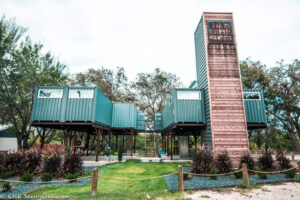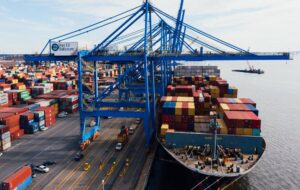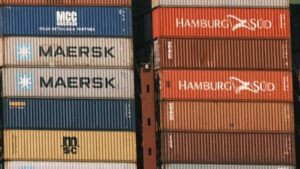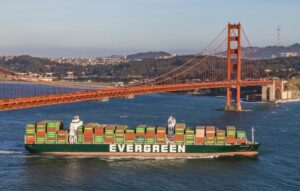In this article, we’ve compiled a huge assortment of shipping container statistics related not only to container houses but the equipment, companies, and processes used to build and move them. Let’s dig in!
Shipping Container Home Statistics

Container homes are often the most popular application of shipping containers, so it’s a great place to start the article.
How many container home builders are there?
There are well over 300 shipping container home builders and designers across the globe (Source: Discover Containers)
What is the average size of a container home?
The average size of a container home is 640 square feet, equivalent to two 40-f00t containers or four TEUs (Source: Discover Containers)
What is the average cost of a container home?
The average cost of a container home is $90,000 but varies dramatically based on size, quality, and amount of DIY labor contributed (Source: Discover Containers)
How long will a container home last?
Container homes can last for over 100 years with proper maintenance and upkeep (Source: Discover Containers)
What is the size of the global container home market?
The world shipping container home market in 2022 is valued between $8.6B and $61.3B.
- $8.6B with a compound annual growth rate of 2.7% from Data Intelo
- $17.74B with a compound annual growth rate of 7.11% from Research and Markets
- $43.99B with a compound annual growth rate of 3.7% from 360 Market Updates
- $44.08B with a compound annual growth rate of 3.7% from Market Reports World
- $54.3B with a compound annual growth rate of 5.9% from The Business Research Company
- $61.3B with a compound annual growth rate of 6.5% from Allied Market Research
Shipping Container Port Statistics

Container ports, most commonly seaports, provide a location to transfer containers from seaborn transit to land, and the reverse. Below are statistics about the surprising amount of cargo that moves through container ports.
How long does it take to unload a single container from a ship?
On average, it takes between 27 seconds and 76 seconds to move a shipping container onto or off of a container ship (Source: Quartz, 2021)
- 27 seconds to load or unload a container from a ship in a port in Asia
- 46 seconds to load or unload a container from a ship in a port in Northern Europe
- 76 seconds to load or unload a container from a ship in a port in North America
How long does an average container ship stay in port for loading and unloading?
On average, a container ship port call will last 0.71 days to load/unload cargo (Source: Statista)
What are the 10 Busiest Container Ports in the World?
The 10 busiest ports in the world by annual TEU (Twenty-foot Equivalent Units) volume are:
- Port of Shanghai, China, 47M TEU (Source: Shanghai International Port Group)
- Port of Singapore, 37.5M TEU (Source: Maritime and Port Authority of Singapore)
- Ningbo-Zhoushan Port, China, 31.1M TEU (Source: Ningbo Zhoushan Port Company Limited)
- Port of Shenzhen, China, 28.8M TEU (Source: Freightwaves)
- Qingdao Port, China, 24.8M TEU (Source: Qingdao Port)
- Port of Guangzho (Nansha), China, 24.5M TEU (Source: Port of Nansha)
- Busan Port, South Korea, 21.8M TEU (Source: Busan Port Authority)
- Port of Tianjin, China, 20.2M TEU (Source: Tianjin Port Development)
- Hong Kong Port, Hong Kong SAR, 17.8M TEU (Source: Hong Kong Marine Department)
- Port of Rotterdam, The Netherlands, 14.3M TEU (Source: Port of Rotterdam)
What are the 10 Busiest Container Ports in the USA?
The 10 busiest ports in the USA by annual TEU volume are:
- Port of Los Angeles, California, 10.7M TEU (Source: Port of Los Angeles)
- Port of New York and New Jersey, New York / New Jersey, 9M TEU (Source: Port of New York and New Jersey)
- Port of Long Beach, California, 8.1M TEU (Source: Port of Long Beach)
- Port of Savannah, Georgia, 5.6M TEU (Source: Georgia Ports)
- Northwest Seaport Alliance, Washington, 3.7M TEU (Source: Northwest Seaport Alliance)
- Port Houston, Texas, 3.5M TEU (Source: Port Houston)
- Port of Virginia, Virginia, 2.8M TEU (Source: Port of Virginia)
- Port of Charleston, South Carolina, 2.8M TEU (Source: South Carolina Ports Authority)
- Oakland Seaport, California, 2.4M TEU (Source: Oakland Seaport)
- Jacksonville Port Authority, Florida, 1.4M TEU (Source: JAXPORT)
What are the 10 Busiest Container Ports in Europe?
The 10 busiest ports in Europe by annual TEU volume are:
- Port of Rotterdam, The Netherlands, 14.3M TEU (Source: Port of Rotterdam)
- Port of Antwerp-Bruges, Belgium, 14.2M TEU (Source: Port of Antwerp-Bruges)
- Port of Hamburg, Germany, 8.7M TEU (Source: Port of Hamburg)
- Port of Piraeus, Greece, 5.4M TEU (Source: Port of Piraeus)
- Valencia Port, Spain, 5.6M TEU (Source: Valencia Port)
- Algeciras Port, Spain, 4.8M TEU (Source: Port of Algeciras Bay Authority)
- Ports of Bermen/Bremerhaven, Germany, 4.8M TEU (Source: Bremenports)
- Port of Felixstowe, United Kingdom, 3.5M TEU (Source: UK Department for Transport)
- Port of Barcelona, Spain, 3.5M TEU (Source: Port of Barcelona)
- Haropa (Le Havre, Rouen, Paris) Port, France, 3.1M TEU (Source: HAROPA Port)
How many shipping container ports are there in the world?
Worldwide there are 939 shipping container ports (UNCTAD)
Container Company Statistics
Container lines, also known as container carriers or container line operators, are the companies that own the ships that carry shipping containers around the world. They often also own their own inventory of empty containers as well.
Container leasing companies work in concert with container lines. These companies own large inventories of containers and lease them out for short and long-term usage by carriers, freight forwarders, and others.
What are the largest Shipping Container Carriers?
The 10 largest shipping container carrier companies by annual TEU capacity are (Source: Alphaliner, 2022):
- MSC, 4.4M TEU
- Maersk, 4.2M TEU
- CMA CGM, 3.3M TEU
- COSCO, 2.9M TEU
- Hapag-Lloyd, 1.7M TEU
- Evergreen, 1.5M TEU
- ONE, 1.5M TEU
- HMM, 0.8M TEU
- Yang Ming Marine Transport, 0.7M TEU
- ZIM, 0.5M TEU
How many shipping container carriers exist in the world?
Over 1,950 line shipping services provide shipping container transport services to ports around the world (Source: World Shipping Council)
What are the major shipping container carrier alliances?
The three major container carrier alliances account for 83% of the global container market (Source: Alphaliner, 2022)
- 2M (Maersk and MSC)
- Ocean Alliance (COSCO, CMA CGM, Evergreen)
- THE Alliance (Hapag Lloyd, ONE, Yang Ming, HMM)
What are the largest Shipping Container Leasing Companies?
The seven major container leasing companies by TEU capacity are:
- TRITON International, 7.3M TEU (Source: TRITON)
- Textainer Group, 4.3M TEU (Source: Textainer)
- Florens Container Leasing, 3.9M TEU (Source: Florens)
- Seaco Global, 2.4M TEU (Source: Seaco)
- Beacon Intermodal, 1.8M TEU (Source: Beacon)
- CAI International, 1.7M TEU (Source: CAI)
- Seacube Containers, 1.2M TEU (Source: Seacube)
How many of the world’s shipping containers do leasing companies own?
As of 2021, container leasing companies own around 52% of the world’s containers (Source: Triton)
Shipping Containers Movement Statistics

Shipping containers are built for a purpose: transporting goods! Below are statistics related to the costs and methods by which containers are moved around the world.
How much of the world’s goods are carried in shipping containers?
From an economic value perspective, 70% of the world’s goods are carried by sea, and 52% of the world’s sea trade is transported in shipping containers (Sources: United Nations Conference on Trade and Development and World Shipping Council)
What are the busiest container trade routes in the world?
The busiest world trade routes for container ships are (Source: United Nations Conference on Trade and Development):
- The East Asia to North America route, with 31.2M TEU annually
- The North Europe and Mediterranean Region to East Asia route, with 26.3M TEU annually
- The North America to North Europe and Mediterranean Region route, with 8.0M TEU annually
What are the longest container routes in the world?
A few of the longest shipping container routes in the world, including intermediate stops, are:
- The Maersk AE6 route from Antwerp, Belgium to Shanghai, China has a 42-day transit period (Source: Maersk, of the 2M Alliance)
- The COSCO AACI route from Nhava Sheva (Mumbai), India to Long Beach, California has a 46-day transit period (Source: COSCO, of the Ocean Alliance)
- The ONE AL5 route from Seattle, Washington to Antwerp, Belgium has a 43-day transit period (Source: ONE, of THE Alliance)
Time to complete the route between ports is especially important for perishable goods, like those transported by refrigerated containers (reefers).
How are the costs to ship containers between major ports measured?
A number of price indexes have been created to track container shipping prices over time, including:
- Shanghai Containerized Freight Index (SCFI) – A weighted average of multiple export routes from Shanghai, China to various ports worldwide, given in cost per shipped 20-foot container (TEU)
- Drewry’s World Container Index (WCI) – A weight-average of container freight rates across eight major east-west routes, given in cost per shipped 40-foot container (FEU)
- Freightos Baltic Index (FBX) – A weighted average of 12 regional route indexes, given in cost per shipped 40-foot container (FEU)
- Xeneta Shipping Index (XSI) – A series of eight regional trade lane costs, given in cost per shipped 40-foot container (FEU)
- Platts Asia to Europe Freight Rates and Platts Southeast Asia to North America Freight Rates – Average costs for the general geographic trade route, given in cost per shipped 40-foot container (FEU), however, the data is not publically accessible
Clicking on any of the above links (except for the Platts indices) will give the latest prices for that index.
Note: The freight price indices calculate pricing in different ways, including or excluding various fees and surcharges, reflecting different spot and short-term contract prices, using different data sources, etc.
What are the main container route choke points?
Choke points are areas where ship traffic must pass through a narrow waterway, often backing up and causing delays. The main transnational choke points are:
- Panama Canal – A 51-mile-long man-made canal connecting the Atlantic and Pacific Oceans across Panama in Latin America
- Strait of Malacca – A 580-mile-long body of water connecting the Indian Ocean and the Pacific Ocean between Malaysia and Indonesia
- Suez Canal – A 120-mile-long man-made canal connecting the Mediterranean Sea and the Red Sea across Egypt
- Strait of Hormuz – A 104-mile-long body of water connecting the Persian Gulf and the Gulf of Oman between Iran and the UAE/Oman
- Turkish Straits – The 19-mile-long Bosphorus and 42-mile-longs Dardanelles connect the Mediterranean Sea to the Black Sea across Turkey
- English Channel – A 350-mile-long body of water connecting the Atlanta Ocean and the North Sea between the United Kingdom and France, and inclusive of the Strait of Dover
- Danish Straits – The 37-mile-long Great Belt, the 31-mile-long Little Belt, and the 73-mile-long Öresund connect the Baltic Sea and the North Sea between Denmark, Sweden, and Germany
- Straight of Gibraltar – A 36-mile-long body of water connecting the Atlantic Ocean and the Mediterranean Sea between Spain and Morocco
- St. Lawrence Seaway – A 370-mile-long system of locks, canals, and channels connecting the Atlantic Ocean and the Great Lakes between Canada and the United States
How many shipping containers are transported each year?
As of 2019, an estimated 226 million shipping containers are moved each year (Source: World Shipping Council)
How many shipping containers are lost at sea each year?
On average, 1,382 shipping containers are lost at sea each year. This is due to reasons like falling overboard, vessel sinkings/groundings, etc. (Source: World Shipping Council and Insurance Journal)
This average is skewed upward by significant vessel incidents in 2013 and 2020.
Container Ship Statistics
Container ships are the workhorses of the shipping container ecosystem. These ocean vessels span from huge to massive, carrying thousands of shipping containers at once over thousands of miles in pursuit of greater economies of scale. Below we share some interesting statistics about these huge machines.
What is the average size of a container ship by carrying capacity?
The average size of a container ship is 3,543 TEU (Source: United Nations Conference on Trade and Development)
What is the largest container ship in the world by TEU capacity?
The largest container ships in the world are the Evergreen A-class family (Example: EVER ACE) with a capacity of 23,992 TEU (Sources: Wikipedia and Wikipedia)
Previously, the largest container ships in the world as of 2019 were the MSC Gülsün-class container ships with a capacity of 23,756 TEU (Source: Wikipedia)
In 2023, MSC is planning to take delivery of several ships in a new class of 24,232 TEU vessels which will then become the largest container ships in the world (Source: Container News)
How much do the largest container ships cost?
The cost of the largest ~23k TEU vessels is $150-170M (Source: Marine Insight, 2021)
How many container ships are there in the world?
The global fleet of large container vessels is 5,587 ships as of 2021 (Source: USDA)
What is the total capacity of all the world’s container ships?
The TEU capacity of the global container vessel fleet is 24.7M TEU (Source: USDA)
Where are large ships, like container ships, built?
94% of global shipbuilding takes place in China, Korea, and Japan (Source: UNCTAD, 2021)
Where are large ships, like container ships, dismantled after they are no longer being used?
88% of global ship recycling takes place in Bangladesh, India, and Pakistan (Source: UNCTAD, 2021)
Where do most large ships hold their flag registration?
26% of ships have flag registration in Panama, Liberia, or the Marshall Islands, while China is at 9% (Source: UNCTAD, 2021)
Where are the beneficial owners of most large ships located?
21% of ships have beneficial ownership in Greece, Japan, and Singapore, while China is at 14% (Source: UNCTAD, 2021)
What are the main types or classes of large container ships used around the world?
There are not really well-defined, industry-standard classifications for the size categories of container ships. However, there are some general ranges and broad categories, despite vague definitions, overlaps, and disagreements between sources.
The main classes of container ships used around the world include (in order of decreasing size):
- Ultra Large Container Ships (ULCS): The biggest current container ships, often considered to be those ships larger than 15,000 TEU capacity
- Post New Panamax (Post Neo Panamax): Ships bigger than the size permitted by the 2016 Panama Canal Expansion, typically greater than 20,000 TEU
- Very Large Container Ships (VLCS): Container ships that typically have between 10,000 and 15,000 TEU capacity
- New Panamax (Neo Panamax): Container ships that can transit through the 2016 Panama Canal Expansion, typically with no more than 14,000 TEU
- Post Panamax (Super Panamax): Container ships that were too big to fit through the original Panama Canal, prior to the 2016 Expansion, typically with 4,000 to 8,500 TEU capacity
- Panamax: Container ships that would fit through the original Panama Canal prior to the 2016 expansion, typically with a maximum capacity of 5,000 TEU
- Feeder: Container ships used for shorter, regional routes to smaller, less-trafficked ports, usually with a capacity of around 2,000 to 3,000 TEU
There are other sub-categories and parallel categories that are less commonly stated, such as Megamax-23, Megamax-24, Suezmax, Feedermax, Malaccamax, etc. There are also some ship sizes that are more commonly used for bulk cargo (dry or liquid), but less so for containers.
Container ships can also be placed into more historical groupings, accounting for the technology improvements in ship design and the changes in port and canal capabilities that enabled larger ship capacities.
- 1st Generation Container Ship: Approximately 1956-1970. These first containerships were converted tankers and bulk cargo vessels. They typically have a capacity of no more than 800 TEU
- 2nd Generation Container Ship: Approximately 1970-1980. These were the first purpose-built container ships, designed with cellular hulls to hold containers. They typically have a capacity of 1,000 to 2,500 TEU
- 3rd Generation Container Ship: Approximately 1980-1988. These container ships marked the era of trying to maximize the size of ships that could fit through the Panama Canal locks, known as the Panamax size. Typically these ships have a capacity of 3,000 to 5,000 TEU
- 4th Generation Container Ship: Approximately 1988-2000. These container ships are from the Post Panamax era, and typically have capacities of between 4,500 and 8,000 TEU
- 5th Generation Container Ship: Approximately 2000-2005. This short era of container ships showed continued refinement of the Post Panamax ships, with capacities ranging from 6,000 to 10,000 TEU
- 6th Generation Container Ship: Approximately 2005-Present. The newest container ships, these ships include the ULCS, most VLCS, and Post New Panamax ships with capacities over 10,000 TEU
Sources: Wall Street Journal, The Rise of Ultra Large Container Vessels: Implications for Seaport Systems and Environmental Considerations, DHL, US Department of Agriculture, An Evaluation of Current Trends in Container Shipping Industry, Very Large Container Ships (VLCSs), and Port Capacities to Accommodate TTIP Increased Trade, Marine Insight, Container Transportation, Transport Geography, World Shipping Council, Wikipedia
Shipping Container Production Statistics

Shipping containers themselves are worthy of their own section of data points. Below are statistics about how containers are manufactured.
How many new shipping containers are manufactured each year?
Over the past 10 years, an average of 2.6 million TEU of containers are produced annually (Source: Triton).
However, due to the impacts of COVID-19, almost 5.2 million TEU of containers were produced in 2021 (Source: Triton).
How long do shipping containers last before they are disposed of or retired?
New shipping containers have a depreciable life of 13 years before they are sold for other uses such as stationary storage or container homes (Source: Triton)
Where are shipping containers made?
95% of shipping containers are manufactured in China. And 82% of shipping containers are made by three Chinese companies: China International Marine Containers, Dong Fang International Containers, and CXIC Group (Source: Federal Maritime Commission)
How big are shipping containers?
The most common size containers are 20-foot containers (roughly 20 ft long, by 8 ft wide, by 8.5 ft tall) and 40-foot containers (roughly 40 ft long, by 8 ft wide, by 8.5 ft tall). Read our Shipping Container Dimensions and Sizes article for much more detail on the dimensions and weights of these and other shipping containers.
Summary
There you have it: one of the most comprehensive collections of data and statistics about shipping containers ever assembled. We hope this information opened your eyes to the scale of shipping containers in our world economy. If you’d like to learn more about containers, our Shipping Container History article has much more information.





